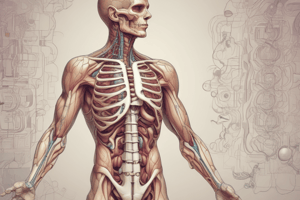Podcast
Questions and Answers
What is the major reaction involved in the digestion of all macromolecules?
What is the major reaction involved in the digestion of all macromolecules?
- Oxidation
- Synthesis
- Hydrolysis (correct)
- Fermentation
What is the first organ in the digestive tract where digestion begins?
What is the first organ in the digestive tract where digestion begins?
- Small intestine
- Mouth (correct)
- Esophagus
- Stomach
What is the function of saliva in the mouth?
What is the function of saliva in the mouth?
- To absorb carbohydrates
- To lubricate the food (correct)
- To break down proteins
- To produce enzymes
What is the movement of food through the digestive tract called?
What is the movement of food through the digestive tract called?
What is the name of the enzyme that breaks down carbohydrates in the mouth?
What is the name of the enzyme that breaks down carbohydrates in the mouth?
What is the result of chewing food in the mouth?
What is the result of chewing food in the mouth?
What is the name of the clump of food formed in the mouth?
What is the name of the clump of food formed in the mouth?
In which part of the digestive tract does no digestion occur?
In which part of the digestive tract does no digestion occur?
What is the primary function of mucous cells in the stomach?
What is the primary function of mucous cells in the stomach?
What is the term for the semifluid mass of food that is produced in the stomach?
What is the term for the semifluid mass of food that is produced in the stomach?
Which type of cell is responsible for synthesizing pepsinogen?
Which type of cell is responsible for synthesizing pepsinogen?
What is the pH of a full stomach?
What is the pH of a full stomach?
What is the function of the proton gradient in parietal cells?
What is the function of the proton gradient in parietal cells?
Which cell type is responsible for secreting gastrin?
Which cell type is responsible for secreting gastrin?
What is the function of the lower esophageal sphincter?
What is the function of the lower esophageal sphincter?
What is the primary function of the stomach?
What is the primary function of the stomach?
Flashcards are hidden until you start studying
Study Notes
Anatomy of the Digestive System
- The digestive tract consists of: mouth, esophagus, stomach, small intestine (duodenum, jejunum, ileum), large intestine (ascending colon, transverse colon, descending colon, sigmoid colon), rectum, and anus.
- The pancreas, liver, and gallbladder are also part of the digestive system.
Mouth and Esophagus
- Digestion begins in the mouth with the breakdown of carbohydrates by amylase in saliva.
- Chewing increases the surface area of food, allowing more enzymes to act on it.
- A bolus is formed in the mouth, which is pushed into the esophagus by swallowing, and then moved down the esophagus via peristaltic action.
- Peristalsis is a wave-like motion of smooth muscle that moves food through the digestive tract.
- No digestion occurs in the esophagus.
Stomach
- The stomach is a flexible pouch that mixes and stores food, reducing it to a semifluid mass called chyme.
- The stomach contains exocrine glands with gastric pits, and begins protein digestion with the enzyme pepsin.
- The low pH of the stomach (pH 2) assists protein digestion and helps kill ingested bacteria.
- There are four major cell types in the stomach: mucous cells, chief cells, parietal cells, and G cells.
- Mucous cells secrete mucus, which lubricates the stomach wall.
- No absorption occurs in the stomach.
Studying That Suits You
Use AI to generate personalized quizzes and flashcards to suit your learning preferences.



